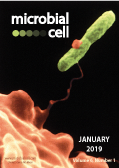Table of contents
Volume 6, Issue 1, pp. 1 - 104, January 2019
Cover: Digitally colorized scanning electron microscopic image depicting the amoeba Vermamoeba (Hartmannella) vermiformis (orange), as it entraps a Legionella pneumophila bacterium (green) with an extended pseudopod. After it is ingested, the Legionella pneumophila bacterium can survive as a symbiont within what then becomes its protozoan host. Under adverse environmental conditions, the amoeba is able to metamorphose into what is known as its cystic-stage, enabling it (and its symbiotic resident pathogen) to withstand such environmental stresses. Image by Barry S. Fields (Centers for Disease Control and Prevention, USA; Public Health Image Library, image ID #6640); image modified by MIC. The cover is published under the Creative Commons Attribution (CC BY) license.
Enlarge issue cover
Guidelines for DNA recombination and repair studies: Cellular assays of DNA repair pathways
Hannah L. Klein, Giedrė Bačinskaja, Jun Che, Anais Cheblal, Rajula Elango, Anastasiya Epshtein, Devon M. Fitzgerald, Belén Gómez-González, Sharik R. Khan, Sandeep Kumar, Bryan A. Leland, Léa Marie, Qian Mei, Judith Miné-Hattab, Alicja Piotrowska, Erica J. Polleys, Christopher D. Putnam, Elina A. Radchenko, Anissia Ait Saada, Cynthia J. Sakofsky, Eun Yong Shim, Mathew Stracy, Jun Xia, Zhenxin Yan, Yi Yin, Andrés Aguilera, Juan Lucas Argueso, Catherine H. Freudenreich, Susan M. Gasser, Dmitry A. Gordenin, James E. Haber, Grzegorz Ira, Sue Jinks-Robertson, Megan C. King, Richard D. Kolodner, Andrei Kuzminov, Sarah AE Lambert, Sang Eun Lee, Kyle M. Miller, Sergei M. Mirkin, Thomas D. Petes, Susan M. Rosenberg, Rodney Rothstein, Lorraine S. Symington, Pawel Zawadzki, Nayun Kim, Michael Lisby and Anna Malkova
Reviews |
page 1-64 | 10.15698/mic2019.01.664 | Full text | PDF |
Abstract
Understanding the plasticity of genomes has been greatly aided by assays for recombination, repair and mutagenesis. These assays have been developed in microbial systems that provide the advantages of genetic and molecular reporters that can readily be manipulated. Cellular assays comprise genetic, molecular, and cytological reporters. The assays are powerful tools but each comes with its particular advantages and limitations. Here the most commonly used assays are reviewed, discussed, and presented as the guidelines for future studies.
Guidelines for DNA recombination and repair studies: Mechanistic assays of DNA repair processes
Hannah L Klein, Kenny K.H. Ang, Michelle R. Arkin, Emily C. Beckwitt, Yi-Hsuan Chang, Jun Fan, Youngho Kwon, Michael J. Morten, Sucheta Mukherjee, Oliver J. Pambos, Hafez el Sayyed, Elizabeth S. Thrall, João P. Vieira-da-Rocha, Quan Wang, Shuang Wang, Hsin-Yi Yeh, Julie S. Biteen, Peter Chi, Wolf-Dietrich Heyer, Achillefs N. Kapanidis, Joseph J. Loparo, Terence R. Strick, Patrick Sung, Bennett Van Houten, Hengyao Niu and Eli Rothenberg
Reviews |
page 65-101 | 10.15698/mic2019.01.665 | Full text | PDF |
Abstract
Genomes are constantly in flux, undergoing changes due to recombination, repair and mutagenesis. In vivo, many of such changes are studies using reporters for specific types of changes, or through cytological studies that detect changes at the single-cell level. Single molecule assays, which are reviewed here, can detect transient intermediates and dynamics of events. Biochemical assays allow detailed investigation of the DNA and protein activities of each step in a repair, recombination or mutagenesis event. Each type of assay is a powerful tool but each comes with its particular advantages and limitations. Here the most commonly used assays are reviewed, discussed, and presented as the guidelines for future studies.
Imbalance in gut microbes from babies born to obese mothers increases gut permeability and myeloid cell adaptations that provoke obesity and NAFLD
Taylor K. Soderborg and Jacob E. Friedman
Microreviews |
page 102-104 | 10.15698/mic2019.01.666 | Full text | PDF |
Abstract
Non-alcoholic fatty liver disease (NAFLD) is a multifactorial disease affecting nearly 40% of obese youth and up to 10% of the general pediatric population. A key aspect of NAFLD pathogenesis is proinflammatory hepatic macrophage activation and hepatic recruitment of circulating monocytes, which originate from the bone marrow. In neonates, the activation and polarization of myeloid immune cells are normally shaped in part by systemic factors derived from intestinal microbiota during the first 1000 days of life. Perturbations of the gut microbiome, and in turn the metabolites and bacterial products released systemically, can affect the functional phenotype of these immune cells. Evidence in germ-free mice has shown that fecal microbial transfer from obese mice or obese human donors promotes obesity and inflammation in the recipients, suggesting a direct role for the gut microbiome in promoting obesity and possibly NAFLD. Indeed, patients suffering from NAFLD show evidence for dysbiosis, increased gut permeability, and changes in bile acids that drive the progression of hepatic inflammation toward non-alcoholic steatohepatitis (NASH), the more severe form of the disease. Compared with infants born to normal-weight mothers, we previously showed that the gut microbiome from neonates born to obese mothers is compositionally distinct. However, whether this alteration in early gut microbiota in infants born to obese mothers can cause inflammatory processes that initiate development of NAFLD or obesity is unknown. How these alterations contribute to long-term immune cell mediated liver inflammation and progression of NAFLD needs to be determined. Our recently published work (Soderborg et al., Nat Commun 9:4462) demonstrates a causative role of early life microbiome dysbiosis in infants born to mothers with obesity in novel pathways that promote developmental programming of NAFLD.










